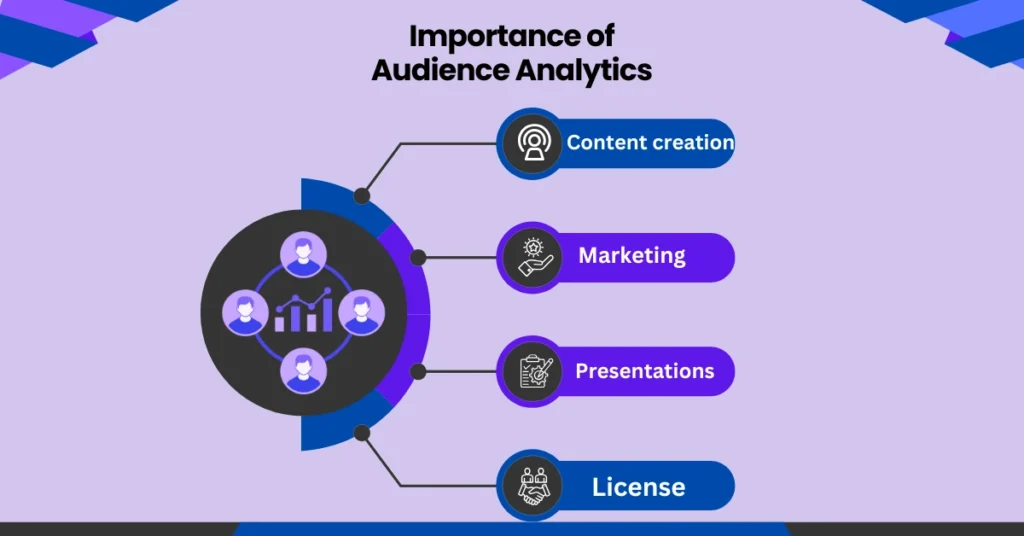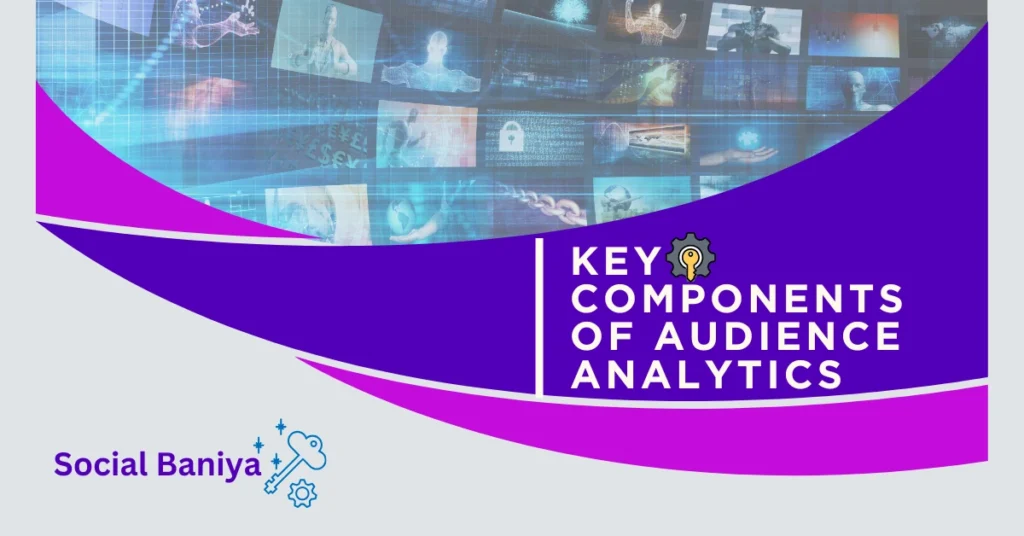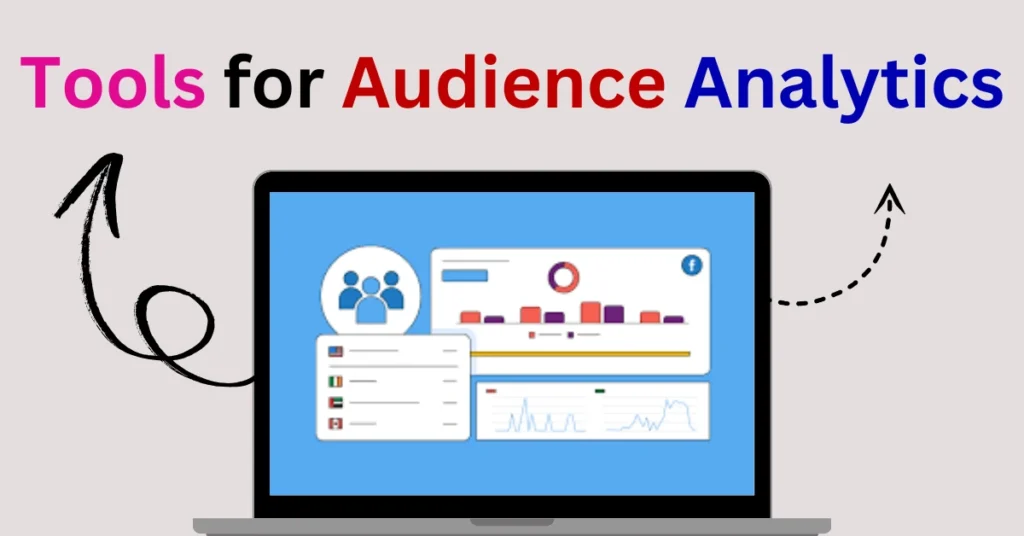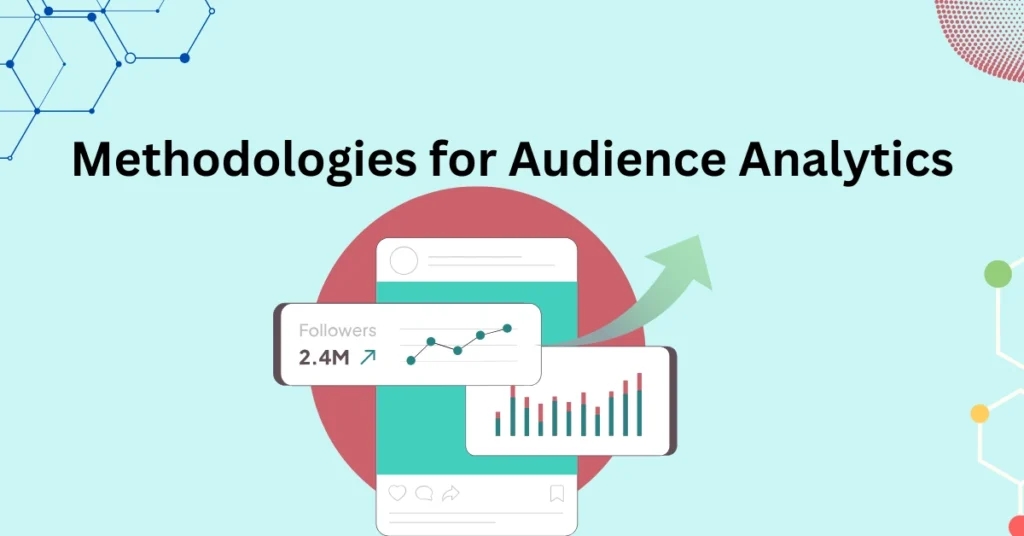In contemporary records-pushed international, know-how your target market is vital for achievement in any industry. Audience analytics is a critical area that enables corporations, marketers, and content creators to collect, examine, and interpret data about their target demographics. By doing so, corporations can enhance their engagement techniques, tailor their offerings, and ultimately power growth. This blog submission will discover audience analytics in detail, protecting its key components, advantages, gear, methodologies, and great practices.
What is Audience Analytics?

Audience analytics is the systematic look at and evaluation of records related to the behaviours, preferences, and demographics of a target audience. It involves accumulating and decoding various records factors, which include web visitors, social media interactions, and engagement metrics, to gain insights into how audiences engage with content across more than one platform. By leveraging tools and technologies, businesses can tune user behaviour in real time, providing a comprehensive view of audience dynamics. These statistics can reveal patterns such as which content material kinds are most attractive, the times whilst audiences are most energetic, and the demographic segments that resonate maximum with unique messages or campaigns. Understanding those elements allows agencies, entrepreneurs, and content creators to tailor their techniques more effectively, optimizing their outreach efforts to meet audience needs. For example, if analytics display that a full-size part of a target audience is engaging with video content material rather than written articles, companies can pivot their content creation method, therefore. Moreover, target market analytics enables perceived audience segments, enabling targeted marketing campaigns that talk without delay about the hobbies and motivations of unique groups. This granularity fosters extra customized studies, improving consumer pleasure and loyalty.
Importance of Audience Analytics:

Understanding your target market is not luxurious; it is a necessity. Here are several reasons why target market analytics is essential:
- Personalization: Personalization in audience analytics entails tailoring content, messages, and reviews to male or female customers or unique target audience segments primarily based on their behaviours, alternatives, and demographics. By reading data gathered from various assets—which include net interactions, social media interest, and purchase records—groups can gain insights into what resonates with distinct audience businesses. This permits the advent of focused advertising campaigns that communicate without delay the desires and pastimes of users, enhancing engagement and delight.
- Data-Driven Decisions: Data-driven selections in audience analytics confer with making strategic picks primarily based on insights derived from information evaluation instead of intuition or guesswork. By employing target market analytics, companies can gather full-size data forcefully consumer behaviours, possibilities, and interactions throughout various structures. These statistics let corporations become aware of developments, determine the effectiveness of advertising campaigns, and recognize the dynamics in their audience.
- Targeted Marketing: Targeted marketing in audience analytics includes developing tailored marketing strategies that concentrate on specific segments of an audience primarily based on records-pushed insights. By reading various statistics factors—together with demographics, pursuits, behaviours, and purchasing records—companies can pick out awesome target audience groups that might be more likely to respond definitely to certain messages or gives. This technique lets brands supply customized content that resonates with personal possibilities, growing engagement and conversion charges. For instance, if analytics reveal that a segment of the target audience broadly speaking includes younger experts inquisitive about green products, centred marketing efforts can highlight sustainable offerings that enchant, especially to this group.
- Improved ROI: Improved ROI in target audience analytics refers to the enhanced go back on investment completed through the strategic use of records insights to tell advertising and enterprise choices. By leveraging audience analytics, organizations can better understand their goal demographics, options, and behaviours, leading to considerable effective marketing strategies that maximize aid allocation. One key thing in improving ROI is the ability to create focused campaigns. By analyzing statistics, groups can perceive which segments in their target market are most likely to interact with precise products or services. This targeted approach reduces waste with the aid of making sure that advertising and marketing efforts reach the proper humans, consequently growing conversion prices and in the end driving sales.
- Adaptation to Trends: Adaptation to tendencies in target market analytics includes leveraging data insights to reply hastily and effectively to moving customer behaviours, preferences, and marketplace dynamics. By constantly tracking target market interactions throughout various structures— social media, websites, and e-mail campaigns—agencies can perceive rising tendencies and adjust their strategies. For example, if analytics screen a growing hobby in sustainability among a target demographic, brands can pivot their messaging and product services to spotlight green practices. This proactive technique no longer best aligns the logo with modern purchaser values however also positions it as an applicable and responsive participant in the market.
Key Components of Audience Analytics:

- Data Collection:
Data series is step one in target market analytics. It entails collecting records from various assets, together with:
- Website Analytics: Website analytics is a critical thing of target audience analytics, focusing on the gathering, measurement, and evaluation of data associated with personal interactions on a website. By utilising gear consisting of Google Analytics, agencies can advantage of deep insights into how traffic interacts with their website, providing valuable facts for optimizing person experience and advertising strategies.
- Social Media Insights: Social media insights in target audience analytics involve the gathering and evaluation of information from social media structures to recognize target audience engagement, options, and behaviours. By leveraging equipment like Facebook Insights, Twitter Analytics, and Instagram Insights, corporations can advantage of precious facts approximately how customers engage with their content material and the general effectiveness of their social media techniques. These insights provide metrics that include likes, stocks, remarks, and follower demographics, permitting manufacturers to evaluate which types of content material resonate most with their audience. For example, if an emblem notices that video posts receive substantially more engagement than static photographs, it can alter its content material approach to prioritize video production.
- Customer Surveys: Customer surveys are an important tool in target audience analytics, allowing agencies to acquire direct remarks from their audience about alternatives, behaviours, and experiences. By designing centred surveys, companies can collect quantitative and qualitative data that provide insights into consumer delight, product usability, and marketplace developments. Surveys may be distributed through numerous channels, such as email, websites, and social media, making it easy to attain an extensive target audience. Questions can range from multiple-desire and score scales to open-ended formats, making an allowance for both dependent information and in-depth responses. This flexibility facilitates businesses in discovering particular insights that might not be obtrusive via other analytics methods.
- CRM Systems: CRM (Customer Relationship Management) systems play a crucial position in audience analytics using centralizing and dealing with customer information, interactions, and insights. These systems enable agencies to gather particular information about customers, such as contact details, buy records, verbal exchange choices, and engagement patterns across various channels. By integrating audience analytics into CRM systems, organizations can benefit from a comprehensive view of their clients, bearing in mind extra personalised interactions and focused marketing techniques. For example, reading information from a CRM can assist pick out excessive-cost clients, understanding their shopping behaviours, and expecting destiny shopping for patterns. This allows agencies to tailor their marketing efforts, supplying personalized hints or promotions that resonate with character options.
- Email Marketing Metrics: Email advertising and marketing metrics are critical components of audience analytics, supplying valuable insights into the effectiveness of email campaigns and target audience engagement. By tracking numerous metrics, agencies can apprehend how recipients engage with their emails, optimize their strategies, and enhance overall performance. Key metrics include open prices, which suggest the proportion of recipients who opened an e-mail; click-through costs (CTR), reflecting the share of customers who clicked on hyperlinks within the electronic mail; and conversion costs, measuring the percentage of recipients who finished a favoured movement, which includes creating a purchase or signing up for a webinar. High open charges can recommend compelling problem strains or targeted target audience segments, while low click-via charges might also suggest a need for extra enticing content or clearer calls to motion.
2. Audience Segmentation
Once facts are gathered, it’s vital to phase the target market. Segmentation permits companies to organize people based on shared traits, making it less complicated to tailor messages and content. Common segmentation standards consist of:
- Demographics: Age, gender, region, profit level, and schooling.
- Psychographics: Interests, values, attitudes, and lifestyle choices.
- Behaviour: Purchase records, engagement degrees, and browsing conduct.
Segmentation can help in developing focused advertising campaigns, making sure that messages resonate with unique target market segments.
- Behavior Analysis
Analyzing how audiences interact with content is essential for knowledge of their possibilities. Key metrics to remember encompass:
- Page Views: The number of instances a selected page is considered can imply its recognition.
- Time on Page: This metric indicates how long users spend on a web page, which could suggest engagement degrees.
- Click-Through Rates (CTR): CTR, or Click-Through Rate, is a key metric in target audience analytics that measures the share of customers who click on a selected link in comparison to the overall number of customers who view a web page, e-mail, or commercial.
- Bounce Rate: Bounce Rate is a critical metric in target market analytics that measures the share of traffic who leave a website after viewing best that web page, without engaging similarly.
2. Trends and Patterns
Identifying tendencies and styles in target audience conduct over the years is crucial for long-term fulfilment. Key elements to analyze include:
- Seasonal Trends: Understanding how audience conduct changes during precise instances of the 12 months can inform marketing strategies.
- Emerging Interests: Keeping a watch on new topics or products that gain traction can help agencies adapt their offerings.
- Feedback Trends: Analyzing client remarks through the years can reveal chronic troubles or areas for improvement.
3. Performance Measurement
Measuring the performance of campaigns and content material is essential for non-stop improvement. Common metrics consist of:
- Conversion Rates: The conversion price measures the proportion of traffic who whole a preferred movement, across creating a buy or signing up for an e-newsletter. It is calculated by dividing the number of conversions through the entire wide variety of traffic and multiplying by a hundred. A better conversion charge shows effective engagement and successful advertising strategies, assisting groups in optimizing their efforts to force more favoured actions from their audience.
- Return on Investment (ROI): ROI, or Return on Investment, in target market analytics, evaluates the profitability of advertising efforts by assessing the sales generated to the fees incurred. It is calculated by subtracting the costs from the entire revenue, then dividing by the total fees and multiplying with the aid of one hundred to explicit it as a per cent. An advantageous ROI suggests that advertising and marketing strategies are powerful in generating cost, and supporting groups make knowledgeable choices approximately resource allocation and campaign optimization.
- Customer Lifetime Value (CLV): Customer Lifetime Value (CLV) in target market analytics estimates the whole sales a commercial enterprise can count on from a consumer throughout their relationship. It considers factors along with buy frequency, average order fee, and patron retention period. By information CLV, companies can better allocate resources for patron acquisition and retention strategies, in the end maximizing profitability and enhancing lengthy-term growth.
Benefits of Audience Analytics:
Enhanced Targeting:
By knowing the unique needs and alternatives of different target audience segments, agencies can create greater personalised and relevant content material. This targeted approach ends in higher engagement and conversion fees, as messages resonate more deeply with the supposed target audience.
Improved Engagement:
Tailored content that speaks directly to the target audience’s pastimes fosters engagement. When audiences experience that a brand is familiar with them, they’re much more likely to engage with content, share it, and emerge as loyal clients.
Informed Decision-Making:
Informed Decision-Making in Audience Analytics involves using data and insights from audience behaviour to guide strategic choices. This process helps organizations better understand their audience, optimize marketing efforts, and improve overall performance.
Competitive Advantage:
Organizations that leverage audience analytics can live in advance of competition with the aid of quick adapting to converting audience behaviours and options. This agility can be a full-size advantage in speedy-paced markets.
Enhanced Customer Experience:
By know-how target market possibilities and ache factors, businesses can enhance their products, services, and customer support. A better client experience regularly translates into higher satisfaction and loyalty.
Tools for Audience Analytics:

Numerous gear can aid in target audience analytics, imparting different features and insights. Here are a few popular options:
- Google Analytics
One of the most widely used net analytics tools, Google Analytics gives comprehensive insights into website visitors, consumer conduct, and conversion metrics. It allows users to song consumer trips, set goals, and examine target audience demographics.
- Facebook Insights
For companies lively on Facebook, Facebook Insights offers treasured information on page overall performance, target audience demographics, and engagement metrics. This data can inform content strategy and advertising and marketing decisions.
- HubSpot
HubSpot’s advertising platform includes tools for target market analytics, electronic mail advertising, and client relationship management. It offers insights into lead conduct, engagement, and conversion metrics.
- Sprout Social
Sprout Social is a social media management tool that offers analytics on audience engagement, sentiment, and demographics throughout numerous social media structures. It enables businesses to recognize how their content plays in real-time.
- SurveyMonkey
For amassing direct remarks from audiences, SurveyMonkey lets organizations create custom surveys. These qualitative statistics can complement quantitative analytics and offer deeper insights into target audience preferences.
- Hotjar
Hotjar offers insights into consumer behaviour through heatmaps, consultation recordings, and surveys. It allows groups to understand how customers interact with their websites and in which upgrades may be made.
Methodologies for Audience Analytics:

To efficiently behaviour target audience analytics, companies can adopt numerous methodologies, which include:
- Descriptive Analytics
Descriptive analytics entails summarizing ancient statistics to recognize what has occurred in the past. It includes analyzing metrics consisting of page perspectives, engagement costs, and demographic information to colour a picture of target market conduct.
- Prescriptive Analytics
Prescriptive analytics goes a step in addition by recommending moves based on facts analysis. It enables groups to perceive satisfactory guides of action to obtain particular dreams, including improving engagement or increasing conversion quotes.
- A/B Testing
A/B trying out involves comparing variations of a chunk of content material to determine which performs better. By studying metrics including CTR and conversion charges, corporations could make information-driven decisions about content and layout.
- Cohort Analysis
Cohort analysis includes reading specific businesses of customers through the years to recognize their behaviour and engagement patterns. This methodology allows enterprises to discover developments and opportunities for improvement.
Best Practices for Audience Analytics:
To maximize the blessings of audience analytics, businesses ought to bear in mind the following satisfactory practices:
- Define Clear Objectives
Before diving into target market analytics, it’s essential to outline clear goals. Understanding what you want to achieve—whether or not it is increasing engagement, improving conversions, or enhancing customer satisfaction—will guide your analytics efforts.
- Use Multiple Data Sources
Relying on an unmarried facts supply can provide a skewed attitude. By combining insights from diverse structures (e.g., website analytics, social media, surveys), businesses can lead to greater complete know-how of their audience.
- Continuously Monitor and Adapt
Audience conduct can change unexpectedly, so it’s essential to continuously reveal analytics and adapt strategies, therefore. Regularly reviewing records helps organizations live relevant and conscious of target audience wishes.
- Foster a Data-Driven Culture
Encouraging a way of life of information-pushed decision-making within the organization can beautify the effectiveness of target audience analytics. Train crew individuals to apprehend and make use of information in their roles, from advertising to product development.
- Respect Privacy and Ethics
As data series are increasingly scrutinized, agencies have to prioritize audience privacy and ethical considerations. Ensure compliance with guidelines (like GDPR) and be transparent about facts utilization to construct consider with your target market.
Conclusion:
Audience analytics is a critical tool for any agency trying to thrive in a competitive panorama. By knowing who your audience is, what they need, and the way they interact together with your content, you can create centred techniques that power engagement and boom. From information series to segmentation, behaviour analysis, and performance size, the components of audience analytics provide a complete framework for knowledgeable choice-making. By leveraging the proper equipment, methodologies, and excellent practices, you could free up the full ability of audience analytics and gain lasting success.
As you embark on your journey into target market analytics, recollect that the insights you gain will empower you to connect with your audience to a deeper degree, ultimately leading to more meaningful relationships and sustainable increases.
FAQ:
What is audience analytics?
Ans. Audience analytics refers to the collection and evaluation of statistics related to the behaviour, preferences, and demographics of an audience. These statistics enable agencies and businesses to recognize their target audience higher.
- Why is audience analytics important?
Ans. It helps agencies tailor their advertising techniques, enhance client engagement, and enhance normal consumers enjoy employing knowledge that resonates with their target market.
- How is audience data collected?
Ans. Data may be amassed through diverse strategies along with internet site analytics gear (e.g., Google Analytics), social media insights, surveys, and patron courting management (CRM) systems.
- How can audience analytics improve my marketing strategy?
Ans. With my expertise in your target market’s alternatives and behaviours, you could create extra applicable content, pick effective channels for verbal exchange, and tailor your messaging to fulfil their wishes.
- What are some advanced techniques in audience analytics?
Ans. Techniques encompass predictive analytics, cohort evaluation, and sentiment evaluation, which can provide deeper insights into target audience behavior and destiny trends.
